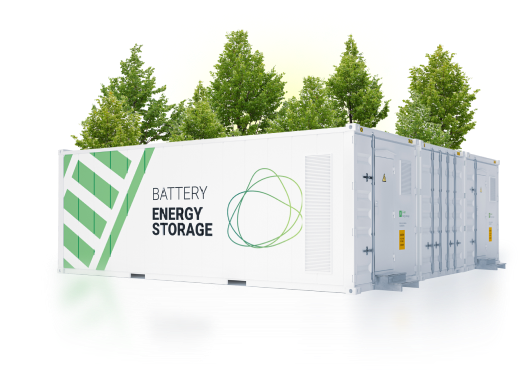|
|
|
Great Oak Energy Hub | Public Consultation
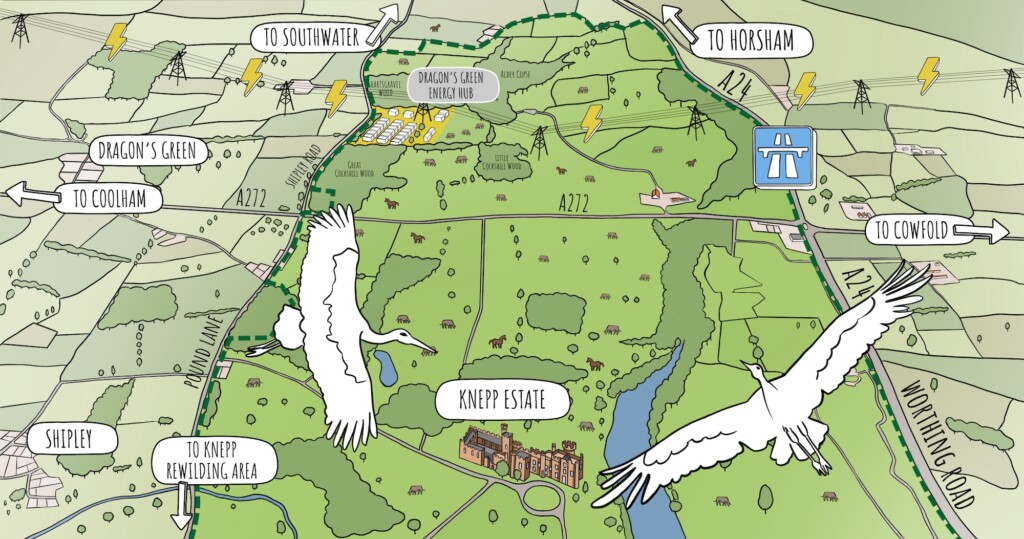
Clearstone Energy is proposing to develop the Great Oak Energy Hub – a 400MW battery energy storage facility – at the Knepp Estate in West Sussex. This webpage provides an overview of the proposal so members of the community can comment prior to the formal planning application being finalised and submitted.
The Energy Hub would store excess electricity available when generation from the UK’s wind turbines and solar farms is higher than demand and release that energy back onto the grid when demand is higher than generation. This network flexibility is urgently needed as we continue to transition UK electricity generation away from gas and coal fired power stations to meet climate change objectives.
The project is located on the Knepp Estate in Sussex, known for its work on rewilding, nature restoration and regenerative farming. It includes a comprehensive package of community benefits to ensure that the local community benefits directly from this local renewable energy project.
Capable of storing energy equivalent to 2 hours power for all homes in Sussex when fully charged
Great Oak Energy Hub Impact

Would displace 110,000 tonnes of CO2 emissions from gas fired power plants each year
Equivalent to planting 5 million trees
+++++++++++++++++++++++++++++++++++++++++++++++++++++++++
Latest News
23rd September 2024 – We have now submitted a planning application for the project.
The application and accompanying documents can be viewed, and representations on the proposal submitted, on the Horsham District Council website here. The planning reference is DC/24/1289. The closing date for comments is 10th October 2024.
—————————————————————————————————————–
25th March 2024 – We are holding a public consultation event on Tuesday 23rd April at Andrew Hall on Red Lane in Shipley (RH13 8PH). The project team will be on site from 2 – 7pm to talk through our proposals and answer your questions.
The pre-application consultation runs until Tuesday 30th April.
We’d love to get your feedback once you’ve read through our proposals. A digital feedback form for the project can be found here
+++++++++++++++++++++++++++++++++++++++++++++++++++++++
THE CRITICAL ROLE OF BATTERY ENERGY STORAGE
Built for an era of coal and gas fired power stations, the existing UK electricity network needs upgrading to support the deployment of renewable, low carbon energy. The inflexibility of the network is adding costs to bills and failing to deliver the emissions reductions needed to prevent climate change.
Batteries solve one of the biggest challenges facing renewable energy. Matching weather dependent solar and wind electricity with household and business electricity demand.
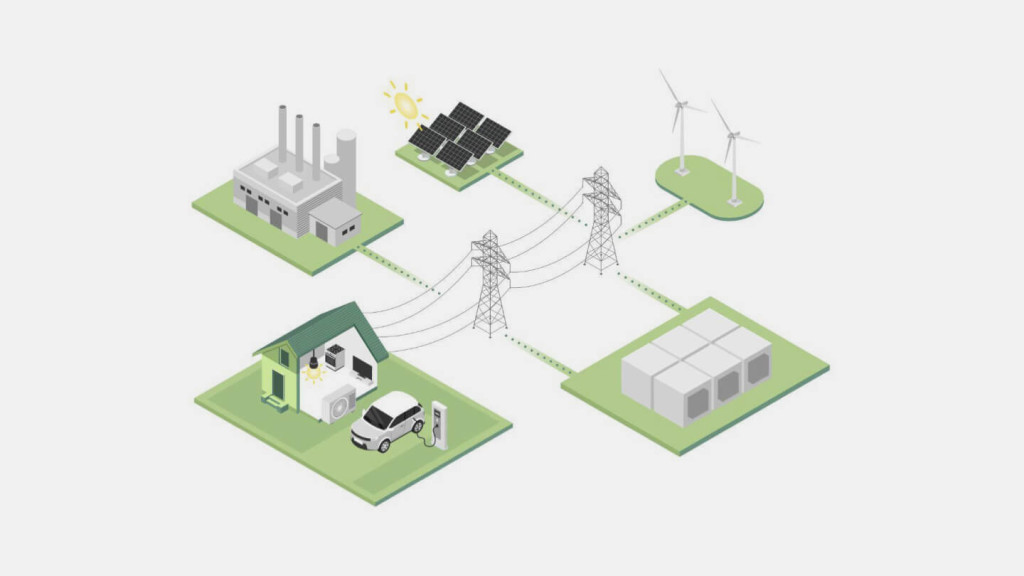
Currently, gas power plants are turned on to supplement wind and solar energy supply and meet peak electricity demand between 7 and 9am and 6 and 8pm
Batteries maximise the amount of renewable energy we can use at home and reduce the number of times we need to turn on a gas fired power plant to meet peak demand, saving money and reducing GHG emissions
Weather dependent wind and solar energy farms often produce more energy than is needed to meet electricity demand overnight and at off peak times during the day
With both supply and demand fluctuating across the day, batteries store energy when there’s more than needed to meet demand and discharge it when there’s less than needed
Example Battery Storage Facility
The total site area for the project is fixed at 17 hectares. Connection to the electricity grid would be via the existing overhead line pylon within the site. The plan below shows an example of what the final scheme could look like. With the feedback gained from this public consultation we will work up a final design for submission to Horsham District Council as part of our planning application for the project. This example design ensures that two thirds of the site is managed for screening and biodiversity benefits and we anticipate the final design will deliver a similar ratio of electrical infrastructure to landscaping and ecology development.
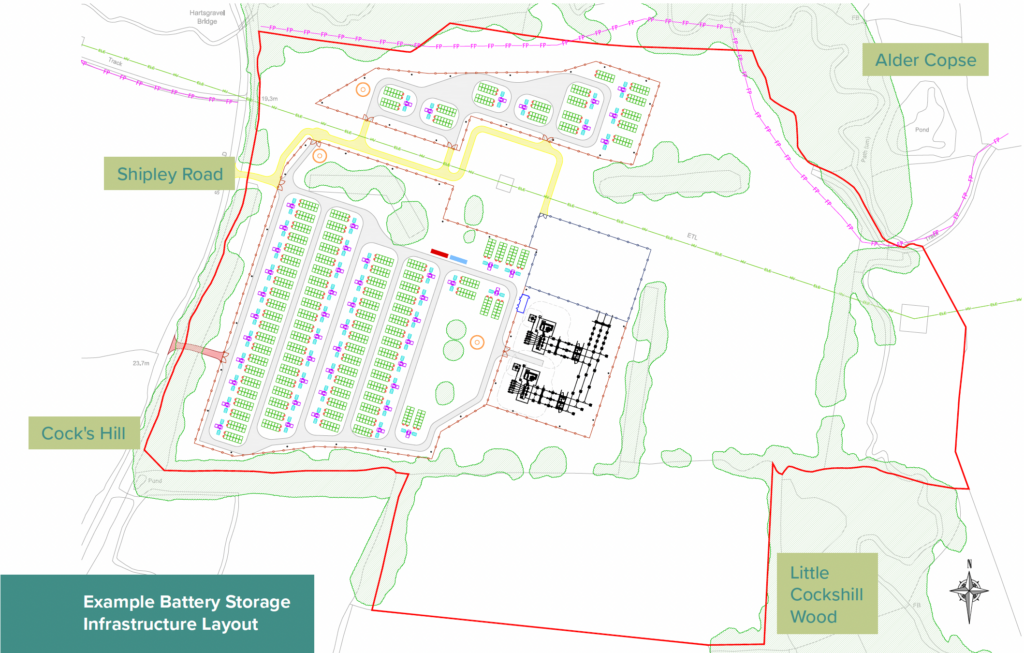
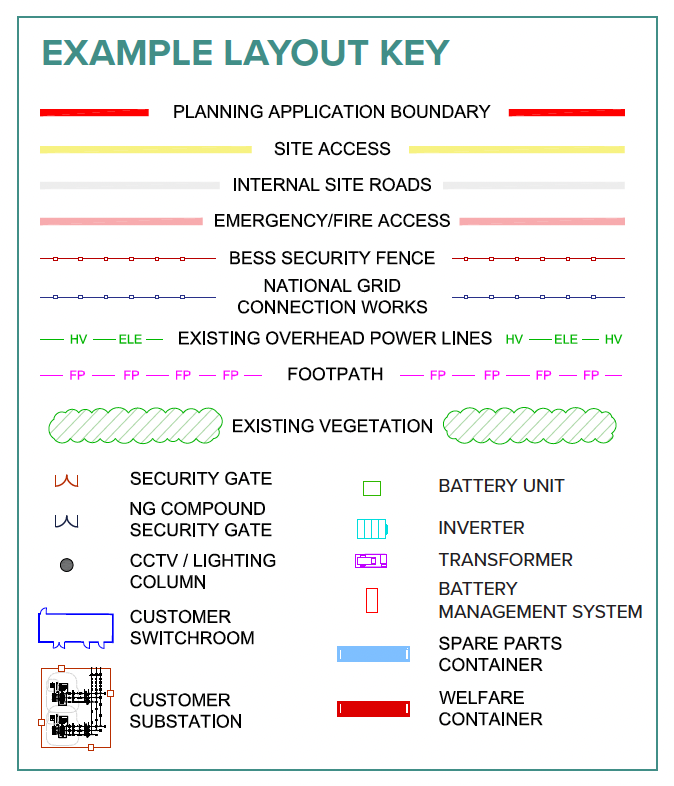
=
Knepp Ethos and Project Involvement
Jason Emrich, Estate Manager
The Knepp Estate was once intensively farmed, but for the past two decades has undergone a remarkable transformation, evolving into a trailblazing rewilding project.
Knepp’s ethos is to enable natural processes to improve soil quality and biodiversity. This ethos is exemplified by the presence of free-roaming grazing animals, whose activities play a pivotal role in driving the process-led regeneration of the land. Knepp has seen extraordinary increases in wildlife since the rewilding project began.
The estate also supports new nature-based enterprises that foster a resilient rural economy. These ventures include organic meat production, eco-tourism initiatives, a new ethical café, restaurant and farm shop, as well as third party business rentals, all of which contribute to the sustainability and vitality of the estate.
Recognising the pressing need to address climate change and promote renewable energy, Knepp is taking steps to support the nation’s net-zero targets through the development of this battery energy storage facility. In line with Knepp’s ethos, the project will be underpinned by meticulous planning and environmental stewardship.
Clearstone Energy was keen for us to help design the environmental measures needed to mitigate the impact of developing the site. We have worked together on a scheme that will connect isolated woodland, create wetland and still enable periodic grazing and the benefits that animals and scrubland bring to biodiversity. We have also stipulated that construction materials and site management will be sustainable and ethical where possible.
The site is quite isolated and not easily overlooked but we have protected long views from the public footpath and will endeavour to enhance the area for visiting public, as well as for wildlife.

Jason Emrich, Estate Manager at Knepp Estate
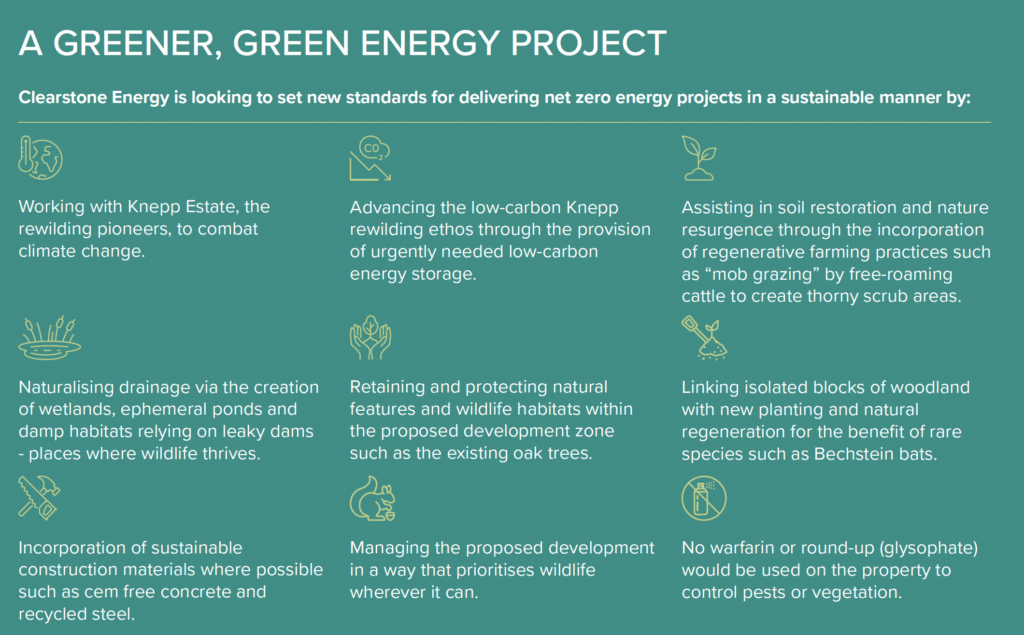
Delivering landscaping and ecology enhancements that improve natural ecosystems
It is estimated that Britain has lost around 50% of its biodiversity since the 1970s due to intensive farming, new housing and commercial development. We are striving to maximise biodiversity net gain across the site, supporting Knepp Estate’s commitment to wildlife.
We anticipate two thirds of the proposed site will be proactively managed for wildlife enhancement and delivering a well screened project. An example of the type of planting and habitats we are considering with Knepp Estate are presented below and we welcome your feedback on these together with the rest of the proposal.

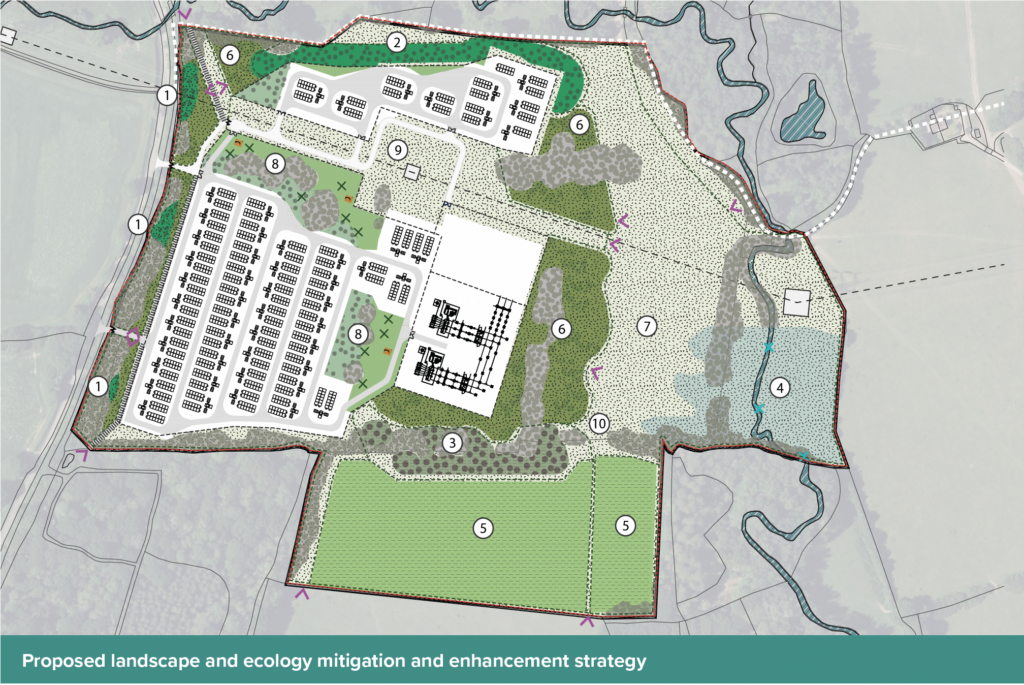
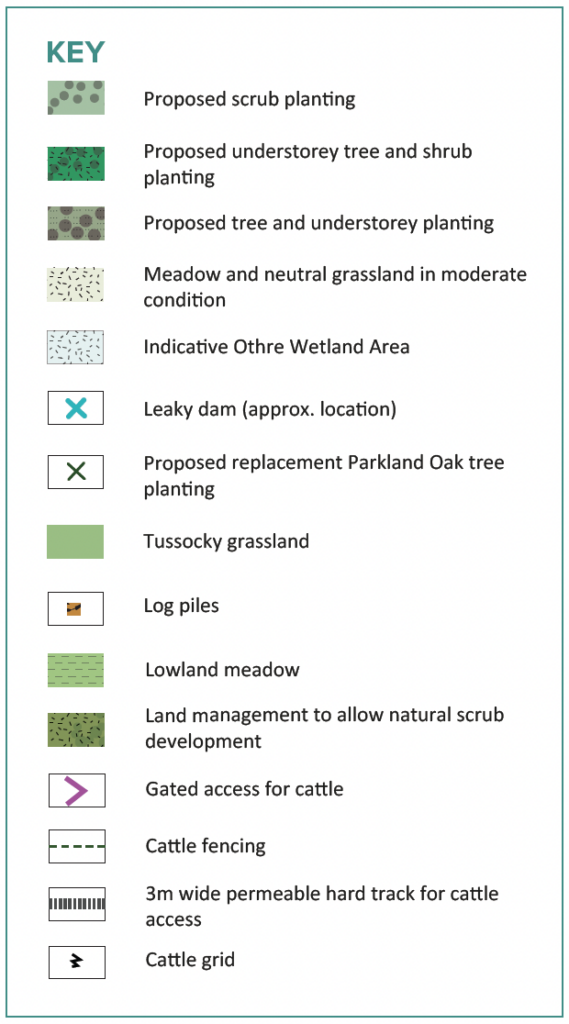
1. Understorey tree planting and shrub vegetation to reduce views from Shipley Road
2. Understorey, trees and shrub vegetation to reduce views from public footpath
3. Additional tree and understorey tree planting
4. Indicative areas of seasonal flooding, ephemeral ponds, wetland and damp habits associated with construction of leaky dams
5. Existing grassland enhanced to create a lowland meadow habitat
6. Land management to allow natural scrub development
7. Land management to allow meadow and grassland development and enhancements
8. Replacement parkland oak tree planting, shrub planting and tussocky grassland
9. Periodic mob grazing to enhance grassland and meadow with additional enhancement through application of green hay
10. Retention of existing gap in the tree line to retain views from footpath towards Cuckoo Barn
Frequently asked questions
No – while the facility would generate some low-level electrical noise from the inverters, switchgear, and fan equipment this noise would not be perceptible beyond the site boundaries. To demonstrate this, a Noise Impact Assessment will be submitted as part of any future planning application.
All Clearstone projects must comply with the standards set out in our comprehensive Battery Safety Standards Plan. Our safety plan draws on best practice from the UK’s National Fire Chiefs Council (NFCC) and the US’s National Fire Protection Agency (NFPA). These standards cover all aspects of the project – technology, site design, installation, operation and emergency response plan – to ensure that it meets the highest safety levels. West Sussex Fire & Rescue Service will be consulted on the project at all stages of its development and operations.
No, this would be a temporary 40-year use of the land, with batteries, other equipment and hard infrastructure removed at the end of the project and the land returned to agricultural use.
Battery units are prefabricated offsite rather than assembled in situ. On site construction will be restricted to the laying of shallow concrete pads for battery containers to sit on and the craning of prefabricated units into position ready for cabling and connection works. As such, project construction would take 12-15 months.
The Lithium-Ion batteries that will be used in the project are not reliant
on scarce raw materials. There are established recycling processes for recovering the most common elements used in battery construction – iron, phosphate and lithium – for re-use.
Typically, there would be three HGVs a day bringing prefabricated units to the site during construction. Construction vehicles will route to the site via the A24, A272 and Shipley Road. The operational traffic would be a light goods van visiting a couple of times a month.
No, there will be no lighting on site.
The maximum height of the batteries would be 3m. However, these would be screened as the site is enclosed by mature woodland. For context, the height of the pylon in the field is 38m.
Who we are
Clearstone Energy is a leading independent developer of renewable energy and energy storage projects that increase the availability of clean energy and improve the resilience of the electricity grid.
We are working with National Grid to develop a portfolio of strategically located solar generation and battery storage projects that will help build a UK energy system based on clean, low cost and renewable energy.
Our experienced team has a track record of developing successful renewable energy projects that are providing clean and reliable energy to communities across the UK.
Since founding in 2016, Clearstone Energy has developed nine energy projects in the UK. Two are operational and seven are in construction.
Talk to us.
As project neighbours your views are really important to us. Digby Willoughby is the Development Manager for the Great Oak Energy Hub project.
Whether it’s comments, feedback or questions we’d love to hear from you.

Following the public consultation
Once the public consultation closes on Tuesday 30th April, we will integrate your feedback into a final project plan and submit a formal planning application for the project to Horsham District Council. As local residents you will be asked for your comments, support or objections to the project as part of the planning application review process. Those living closest to the site will typically be contacted by letter by the Council when the planning application has been received.
We also send details of the planning application by email to those residents that we have email addresses for. If you would like us to do that for you please submit your email address here.
SEND ME PLANNING APPLICATION DETAILS






